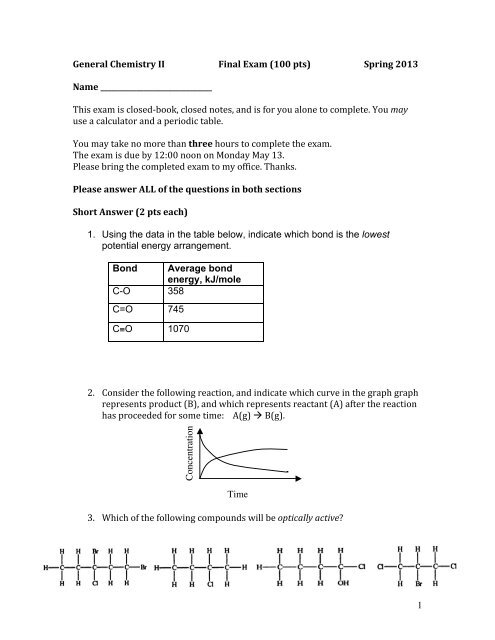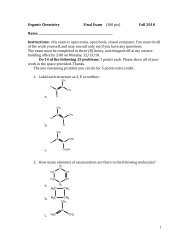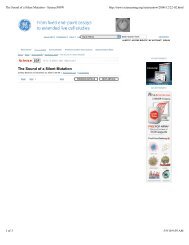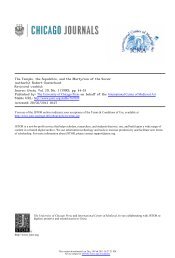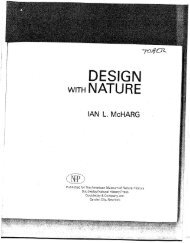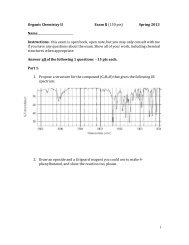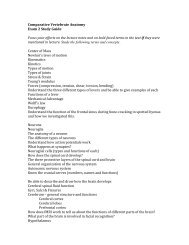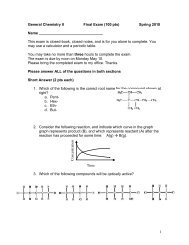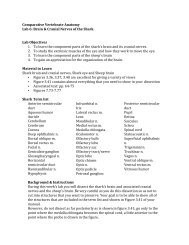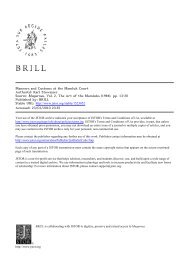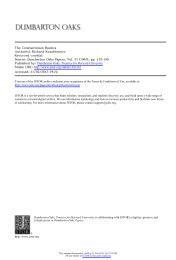1 General Chemistry II Final Exam (100 pts) Spring 2013 ... - Courses
1 General Chemistry II Final Exam (100 pts) Spring 2013 ... - Courses
1 General Chemistry II Final Exam (100 pts) Spring 2013 ... - Courses
You also want an ePaper? Increase the reach of your titles
YUMPU automatically turns print PDFs into web optimized ePapers that Google loves.
<strong>General</strong> <strong>Chemistry</strong> <strong>II</strong> <strong>Final</strong> <strong>Exam</strong> (<strong>100</strong> <strong>pts</strong>) <strong>Spring</strong> <strong>2013</strong> <br />
Name _______________________________ <br />
This exam is closed-‐book, closed notes, and is for you alone to complete. You may <br />
use a calculator and a periodic table. <br />
You may take no more than three hours to complete the exam. <br />
The exam is due by 12:00 noon on Monday May 13. <br />
Please bring the completed exam to my office. Thanks. <br />
Please answer ALL of the questions in both sections <br />
Short Answer (2 <strong>pts</strong> each) <br />
1. Using the data in the table below, indicate which bond is the lowest<br />
potential energy arrangement.<br />
Bond Average bond<br />
energy, kJ/mole<br />
C-O 358<br />
C=O 745<br />
C≡O 1070<br />
2. Consider the following reaction, and indicate which curve in the graph graph <br />
represents product (B), and which represents reactant (A) after the reaction <br />
has proceeded for some time: A(g) B(g). <br />
Concentration<br />
Time<br />
3. Which of the following compounds will be optically active? <br />
1
4. Which of the following statements describes the correct method of <br />
preparation of 1.00 L of a 2.0 M urea solution? urea= 60.06 g/mol <br />
A. Dissolve 120 g of urea in 1.00 kg of distilled water. <br />
B. Dissolve 120 g of urea in 880 g of distilled water. <br />
C. Dissolve 120 g of urea in enough distilled water to produce 1.00 L of <br />
solution. <br />
D. Dissolve 120 g of urea in 1.00 liter of distilled water. <br />
E. The density of urea is needed in order to do this calculation. <br />
5. For the following reaction, what is the reaction rate in terms of each reactant <br />
& product? 2N2O5(g) 4NO2(g) + O2(g) <br />
6. Give the condensed electron configuration and partial (valance) orbital <br />
diagram for Br. <br />
7. Write complete Lewis dot structures for the following molecules, and <br />
indicate ideal bond angles for each: <br />
a. AlCl3 <br />
b. CF4 <br />
c. SF6 <br />
8. What is the hybridization of each carbon in C2H2? <br />
2
Long Answer (7 <strong>pts</strong> each) <br />
1. The compound RX3 decomposes according to the equation: <br />
3RX3 → R + R2X3 + 3X2 <br />
In an experiment the following data were <br />
collected for the decomposition at <strong>100</strong>°C. What is <br />
the average rate of reaction over the entire <br />
experiment? <br />
t(s) [RX3](mol L -‐1 ) <br />
0 0.85 <br />
2 0.67 <br />
6 0.41 <br />
8 0.33 <br />
12 0.20 <br />
14 0.16 <br />
2. Hydrogenation of double and triple bonds is used to prevent unsaturated <br />
oils from oxidizing. Another application of hydrogenation is the conversion <br />
of acetylene to ethane. Calculate (in kJ) the standard enthalpy change (ΔH°) <br />
for the hydrogenation of ethyne (acetylene) to ethane. <br />
H-‐C≡C-‐H(g) + 2H2(g) → H3C-‐CH3(g) <br />
Bond: C-‐C C≡C C-‐H H-‐H <br />
Bond energy 347 839 413 432 <br />
(kJ/mol): <br />
3
3. In class we repeated the assertion that there is “no temperature change <br />
during a phase change.” Imagine an uncovered pot of water being heated on <br />
a stove. Why is there no temperature change (i.e., why isn’t the water in the <br />
pot getting hotter) even as we continue to apply thermal energy to the <br />
system (heating the pot of water)? <br />
4. How does the following figure help illustrate why a chemical reaction will <br />
form more product at a higher temperature? <br />
Number of molecules<br />
4
5. If you have one liter of a 0.5 M aqueous solution of MgCl2, how many ions <br />
will there be in that one liter of solution? <br />
6. Which of the following two molecules will have a lower boiling point, and <br />
why? <br />
A<br />
B<br />
H 3 C<br />
H 2<br />
C<br />
C<br />
H 2<br />
OH<br />
HO<br />
H 2<br />
C<br />
C<br />
H 2<br />
OH<br />
5
7. Potassium fluoride, KF, is used for creating “frosted” glass. Calculate the <br />
molarity of a solution prepared by dissolving 78.6 g of KF in enough water to <br />
produce 225 mL of solution. <br />
8. Identify the two principal products of the reaction between ammonia and <br />
ethyl propionate. Will the products be pair a, or pair b?. What electron <br />
arrangements in the propionate and ammonia promote this reaction? (hint: <br />
where appropriate, add lone pairs to the structures below) <br />
Propionate <br />
ammonia <br />
6
9. For the reaction: 3A(g) + 2B(g) → 2C(g) + 2D(g) <br />
the following data was collected at constant temperature. Determine the <br />
correct rate law for this reaction. <br />
Trial Initial [A] Initial [B] Initial Rate <br />
(mol/L) (mol/L) (mol/(L·min)<br />
) <br />
1 0.200 0.<strong>100</strong> 6.00 × 10 -‐2 <br />
2 0.<strong>100</strong> 0.<strong>100</strong> 1.50 × 10 -‐2 <br />
3 0.200 0.200 1.20 × 10 -‐1 <br />
4 0.300 0.200 2.70 × 10 -‐1 <br />
7
10. When a fuel is oxidized in a combustion reaction, for example the <br />
combustion of propane in a camping stove, where does the energy come <br />
from that is providing the heat for cooking food? <br />
8
Crossword. 0.5 point for each correct answer (14 <strong>pts</strong>). <br />
10


